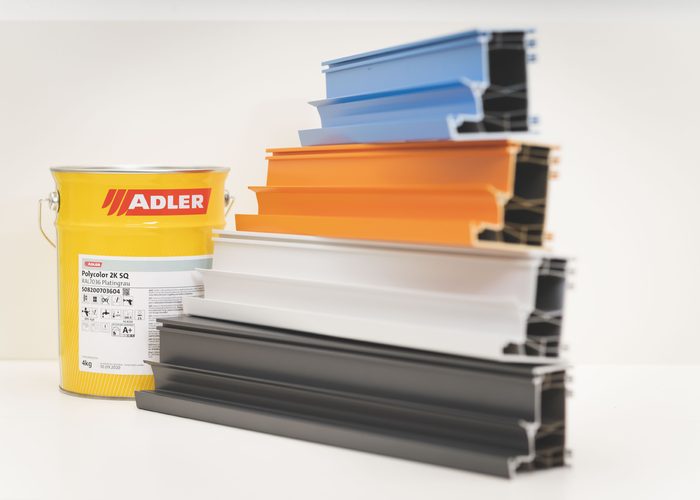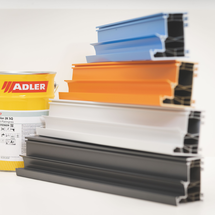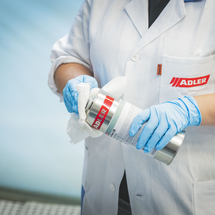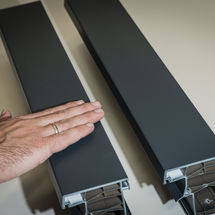
From yellow to green: painting plastic surfaces
Plastic elements are omnipresent in today's architecture. Whether it's used in windows, doors, garden furniture or decorative elements such as flower pots – plastic has established itself as a versatile material. To give these items a more attractive appearance, it is advisable to use high-quality plastic coatings. These can provide an optimal solution for aesthetic enhancement and also prove to be advantageous in terms of durability.
But what possibilities do plastic coatings offer? How can they be used to improve the appearance of products or increase their durability? From yellow to green – find out all about the wide range of colours and surfaces offered by this innovative technology!
Steps
-
Coating PVC, PMMA or GRP: what different types of plastic are there?
There are numerous different kinds of plastic. To avoid any unpleasant surprises during the painting process, it is important that you have an understanding of the properties of your plastic surface.
• PVC or polyvinyl chloride is a very commonly used plastic. It is hard and brittle, white in colour and is made malleable through the use of plasticisers and stabilisers, and it is suitable for technical applications. PVC is best known for its use in flooring.
• PMMA is a transparent material that is particularly valued for its scratch resistance. Polymethyl methacrylate is often used as an alternative to glass.
• Glass reinforced plastic (GRP) is also known in everyday language as fibreglass. Thanks to the fibre/plastic composite, this material is extremely pressure-resistant and is dimensionally stable at high temperatures.
In addition to the types mentioned above, there are also many other plastics, including PS, PC, PET and ABS. The wide variety of plastics available underscores the need for precise inspection and comprehensive testing. In our in-house laboratory and application technology department, which have a total of 120 employees, we have the facilities to analyse materials and components in detail. This means that we can guarantee an optimum coating solution.
-
Challenges when coating plastic
Adhesion is probably the biggest challenge when coating plastics. One reason for this is the surface energy. This is a measure of the wettability of surfaces with liquids such as paints. The low surface energy of plastics makes it difficult for coating systems to adhere to them, and chemical and mechanical resistance must also be taken into account. If the plastic components are to be subjected to stress, consideration will need to be given to the mechanical properties of polymers. The question of elasticity also poses a challenge. When coating soft plastics such as tarpaulins or films, the paint system must be flexible, yet at the same time hard and weather-resistant.
A combination of the Polyactive activator and the Polycolor coating system mean that it is now easy to overcome this problem. Both systems are designed to provide both good adhesion and a high degree of elasticity.
-
Activation of plastics
The Polyactive bonding agent is considered a problem solver when it comes to ensuring good adhesion of the plastic coating to a wide variety of components. This activator guarantees perfect adhesion of the topcoat, for example to smooth PVC, and ensures long-lasting water resistance. It can be applied to the component in question manually or through the use of plasma technology.
-
Application of plastic coatings
The most appropriate way to apply the coating will depend on the area of application and the shape of the object to be coated. The classic method of applying the paint is by means of manual spraying. Details of the exact quantities required can be found in the relevant technical data sheet. For items with complex geometries, such as chairs or special frames, good results can be achieved through the use of cobots or other spray painting robots, which ensure excellent quality and a high degree of accuracy and repeatability. For the industrial coating of elongated parts, we recommend Vacumat coating, which guarantees consistent production quality with overspray-free coating. For flat components with a low profile, a suitable method would, for example, be industrial coating with a spray painting machine.
-
Design options for plastics
In addition to the technical aspects, the aesthetic component also plays a role in the painting of plastics. Polycolor offers numerous options for achieving an individual look. For example, the surface can be given a special character through the addition of texture pastes. Polycolor can also be tinted very easily to achieve any RAL or NCS colour using the ADLER | MIX colour mixing system. This creates a new level of flexibility, as you can now purchase just one version of an item and still cover all colours!
-
Durability and UV resistance of plastic coatings
A high-quality plastic coating is characterised by its resistance to scratches, chemicals and UV radiation. It should also be able to withstand the stresses and strains of daily use. In order to fulfil these requirements, the surface of the plastic, which is usually smooth, must be prepared by treating it beforehand. An activator such as Polyactive or Polyprimer 2K SQ etches the surface and optimises the surface tension. This allows the subsequent application of paint to achieve optimum and long-lasting results.
UV-resistant paint for plastic
Polycolor by ADLER is also available with Anti-Heat properties for certain darker colours, which lead to a significantly reduced surface temperature during exposure to direct sunlight. This then reduces any thermal damage caused by deformation.
-
Conclusion: From yellow to green – painting plastic
Firefighters' helmets, door thresholds or decorative elements – the possibilities for the use of plastics are many and varied. With the right coating, your item is not only given optimal protection against scratches, chemicals and UV radiation, it will also perform excellently in terms of durability.
Which paint should I use for painting plastic?
Polycolor offers the perfect solution for plastics such as PC, PMMA or GRP. Here too, the paint forms a flexible but durable protective layer and ensures long-lasting colour brilliance and shine. Polycolor also offers you complete creative freedom when it comes to colours and textures.
ADLER's Innolux products offer the perfect solution for roller application, for example for plastic edges or other flat components. For digitally printed plastic parts or tarpaulins, we recommend our system solution, which consists of the adhesive primer Print Primer and the protective coating Print-Protect.
© by adler-lacke.com













